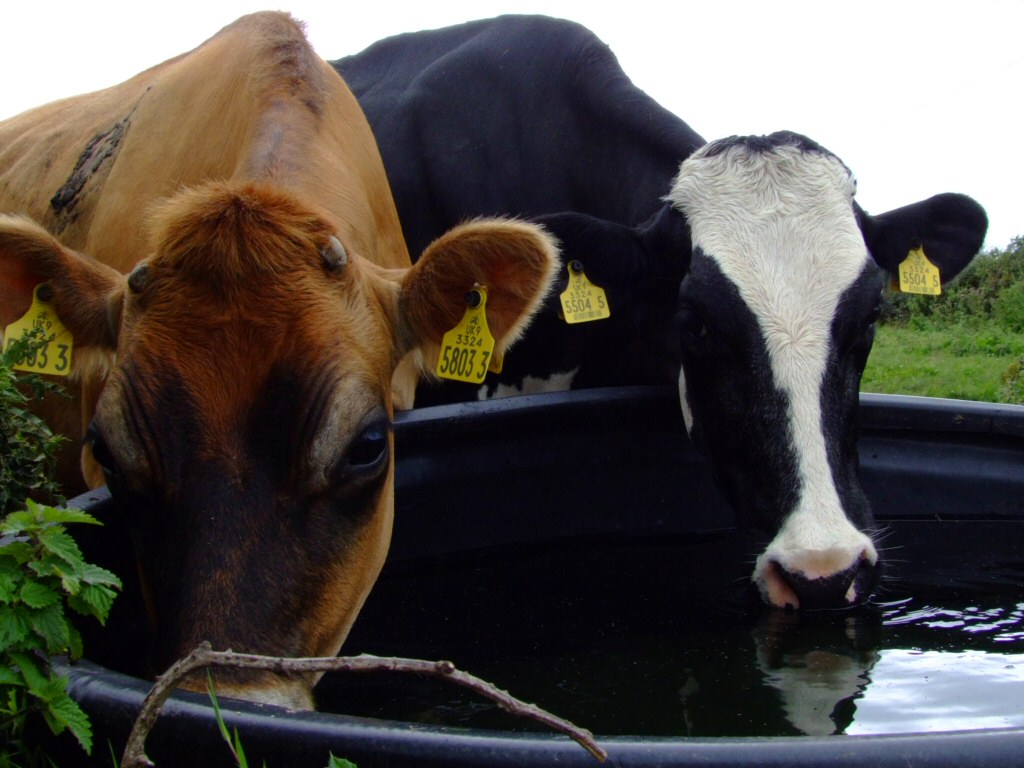 As temperatures increase, so does the water requirement of our livestock. Most livestock owners know the nutrient content of the grains and forages they are feeding their livestock and can tell you if the feedstuff is low, medium or high quality. Do you know how your livestock water quality measures up? Water is the most essential of all nutrients required for our livestock but often other than making sure that water is available in sufficient quantity, little thought is given to the quality of that water. A lactating dairy cow has the highest daily water requirement of any of our farm livestock, consuming on average 25 gallons of water per day. Given that milk is 87% water, it is understandable that the daily water intake is so high. A lactating beef cow will drink on average 14-15 gallons/day; lactating sheep between 3-4 gallons/day, goats between 2-3 gallons/day and a lactating sow around 5 gallons/day. However the quantity of water consumed can be influenced by quality factors such as odor, taste, physical and chemical properties, mineral content, toxic compounds and microbial contamination. If quality is not adequate then consumption decreases which can affect animal performance and health.
As temperatures increase, so does the water requirement of our livestock. Most livestock owners know the nutrient content of the grains and forages they are feeding their livestock and can tell you if the feedstuff is low, medium or high quality. Do you know how your livestock water quality measures up? Water is the most essential of all nutrients required for our livestock but often other than making sure that water is available in sufficient quantity, little thought is given to the quality of that water. A lactating dairy cow has the highest daily water requirement of any of our farm livestock, consuming on average 25 gallons of water per day. Given that milk is 87% water, it is understandable that the daily water intake is so high. A lactating beef cow will drink on average 14-15 gallons/day; lactating sheep between 3-4 gallons/day, goats between 2-3 gallons/day and a lactating sow around 5 gallons/day. However the quantity of water consumed can be influenced by quality factors such as odor, taste, physical and chemical properties, mineral content, toxic compounds and microbial contamination. If quality is not adequate then consumption decreases which can affect animal performance and health.
Some of the common parameters included in a water quality lab analysis includes: pH, total dissolved solids, nitrate nitrogen, sulfate, hardness, calcium, magnesium, potassium, sodium, copper, manganese, zinc and iron. If a water quality problem is suspected it is also useful to know the total coliform bacteria content and the E. coli bacteria content. Some of these parameters have guidelines and limits associated with them and others do not. Some of these parameters will be reported in milligrams per liter (mg/L) which is equal to parts per million (ppm). I’ll briefly examine some of those parameters that have some generally accepted guidelines.
The preferred drinking water pH for humans is between 6.5 and 8.5. There are not many studies that have linked drinking water pH to health and performance issues in livestock and it is generally accepted that the pH should be between 6.0 and 9.0 for most livestock species. Total dissolved solids (TDS) are a sum of all of the inorganic contaminants in water. Drinking water TDS content of less than 1000 ppm is considered ideal for dairy cows, but levels below 3000 ppm are generally considered safe to drink. Nitrates and sulfates should be carefully looked at because they can occur in both feedstuffs and water and levels are additive. For nitrates the level in water should be below 20 ppm as long as feedstuffs contain low nitrate levels. With regard to sulfate, the maximum level should be less than 1000 ppm for adult animals and less than 500 for young animals such as calves. High sulfate levels can cause reduced intake, can cause copper deficiencies and can contribute to the development of polioencephalomalacia; a neurological disorder.
Water hardness is measured by the concentration of calcium, magnesium, iron and manganese cations. Generally water hardness does not directly impact water consumption but there are mineral interactions associated with hard water that can affect the absorption of other minerals. For example, high iron concentration in water can limit copper and zinc absorption and high calcium levels may reduce selenium absorption. The upper limit guidelines for some of the minerals commonly included in water quality test analyses are: Copper below 1.0 ppm or below 0.5 ppm if water flows through copper pipes, below 0.3 ppm for sheep which are very sensitive to copper, Manganese, below 0.05 ppm, Iron below 0.30 ppm, and Zinc below 24 ppm.
With regard to coliform bacteria, the standard is 0 coliform bacteria per 100 milliliters (mL) of water for washing equipment and cleaning milking cow udders and teats, but research in Pennsylvania on over 200 dairy herds was not able to show a correlation between bacteria and herd health issues. It is recommended that drinking tanks and troughs be cleaned regularly to reduce concentrations of coliform bacteria. On the subject of E. coli bacteria there is agreement that presence of E. coli is much more serious than total coliform bacteria. The guideline is less than 1 colony per 100 mL of water.
A final consideration that may or may not be defined as water quality but can definitely influence water consumption is water temperature. Cattle and probably other livestock species as well, prefer drinking water at temperatures between 40 and 65 degrees F. When the water temperature gets above 80 degrees F intake often decreases.
For more information about water quality or where to get a water quality test, contact your local Extension office or see OSU Extension Fact Sheet AEX-315-10, Where to Have Your Water Tested.
Source: OSU Extension











